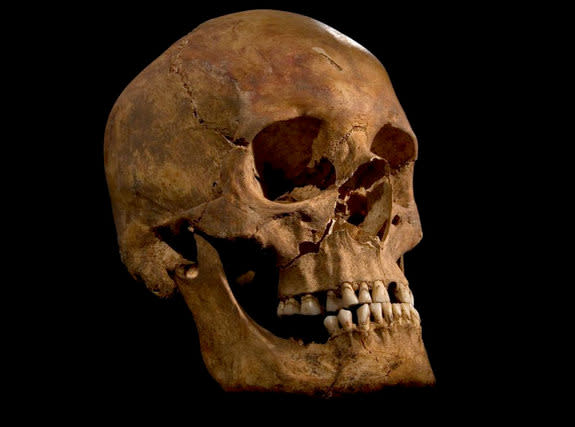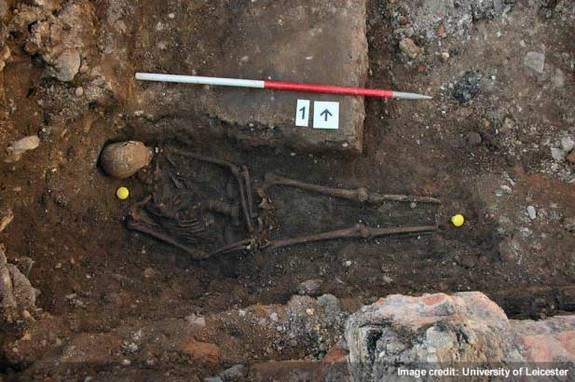Battle-Bruised King Richard III Buried in Hasty Grave
The body of King Richard III was buried in great haste, a new study finds — perhaps because the medieval monarch's corpse had been out for three days in the summer sun.
The new research is the first academic paper published on the discovery of Richard III, which was publically announced in February 2013. A team of archaeologists from the University of Leicester found the body beneath a parking lot in Leicester that was once the site of a medieval church. The full study will be available online on Friday evening (May 24).
The archaeological analysis contains details only alluded to in the initial announcement of the findings. In particular, the archaeologists found that Richard III's grave was dug poorly and probably hastily, a sharp contrast to the neat rectangular graves otherwise found in the church where the king was laid to rest. [Gallery: The Discovery of Richard III]
Richard III's journey to Leicester
Richard III ruled England from 1483 to 1485, when he was killed during the Battle of Bosworth Field, the definitive fight in the War of the Roses.
Historical records reveal that after the battle, Richard's body was stripped and brought to Leicester, where it remained on public display for three days until burial on August 25, 1485. The church where the body was interred, a Franciscan friary called Grey Friars, was eventually demolished around 1538. A former mayor of Leicester built a mansion on the site, but by the 1700s, the land had been subdivided and sold off, the location of the church lost.
With it went all memory of where one of England's most famous kings was buried. Richard III was immortalized by a Shakespeare play of the same name and made out to be a villain by the Tudor dynasty that followed his rule. Today, however, there are societies of Richard III enthusiasts called Richardians who defend the dead king's honor. One of these Richardians, a screenwriter named Philippa Langley, spearheaded the excavation that discovered Richard III's body.
Digging for Richard
The new paper, published in the journal Antiquity, outlines how archaeologists dug three trenches in a city government parking lot, hoping to hit church buildings they knew had once stood in the area. They soon found evidence of the friary they were looking for: first, a chapter house with stone benches and diamond-pattern floor tiles. This chapter house would have been used for daily monastery meetings.
South of the chapter houses, the excavation revealed a well-worn cloister walk, or covered walkway. Finally, the researchers found the church building itself. The church was about 34 feet (10.4 meters) wide. It had been demolished, but the floors (and the graves in the floor) were left intact. Among the rubble were decorated tiles and copper alloy letters that likely once marked the graves.
Brick dust suggested the outer church walls may have been covered with a brick façade, which would have created a striking red-and-white look with the church's limestone-framed windows, the researchers wrote.
A hasty grave
Most of the graves in the Grey Friars church floor are neat and orderly, with squared-off rectangle sides. Richard III's is an exception. The grave is irregularly shaped, with sloping sides. It was also too small for the 5-foot-8-inch (1.7 m) skeleton interred within: Richard's torso is twisted and his head propped up rather than laid flat. The body was also crammed against the north wall of the grave, perhaps because someone stood against the south wall to guide the body into its resting place. Whoever it was did not spend time afterward rearranging the body into a more symmetrical position.
"The haste may partially be explained by the fact that Richard’s damaged body had already been on public display for several days in the height of summer, and was thus in poor condition," the researchers wrote.
There was no coffin in the grave, and likely no shroud, judging by the loose position of the skeleton's limbs. However, the corpse's hands were crossed and perhaps tied in front of him.
The study also delineates the 10 injuries on the corpse's skeleton. Most are likely battle wounds, including two fatal blows to the back of the head. Two wounds on the face, one to the ribs and one to the buttock were likely delivered post-mortem, after Richard III was stripped of his armor, the researchers wrote. These "humiliation wounds" may have been designed to disrespect the king in death.
Follow Stephanie Pappas on Twitter and Google+. Follow us @livescience, Facebook & Google+. Original article on LiveScience.com.
Copyright 2013 LiveScience, a TechMediaNetwork company. All rights reserved. This material may not be published, broadcast, rewritten or redistributed.




